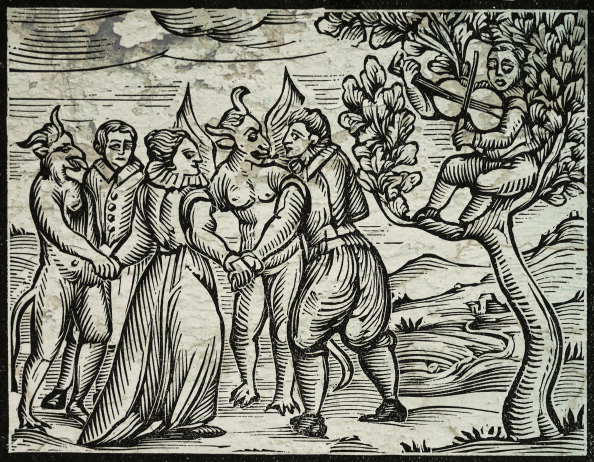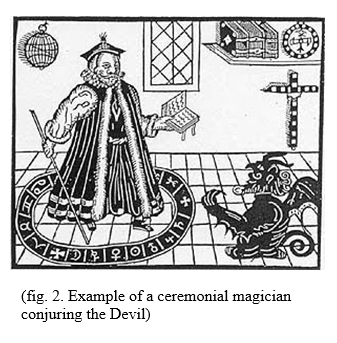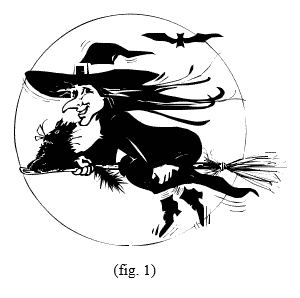
Scott Eaton, MA student in the School of History, reports on the challenges he faces while researching his MA Dissertation topic…
In today’s world we often think of a witch as an ugly old woman who keeps a black cat as a pet, wears a large crooked hat and cloak, and often flies across the sky at night on a shoddy broom stick (fig. 1). Although some of these caricatures are indeed remnants of early modern beliefs that have persisted to the present day, centuries ago, witches were not so benign. In seventeenth century Europe the prospect of encountering such a creature would fill many with sheer terror. In order to understand their concept of witchcraft, we have to situate it within the culture’s wider beliefs of the supernatural.
The majority of Europe’s elite were thoroughly convinced of the diabolic nature of all magic. They believed that magic was not derived from God, therefore, it had to be from Satan. From the fourth century Christian theologians had continually stressed this idea, however, it was not until the late 1400s when the diabolic origins of witches really gained momentum in Europe, as can be seen by the publishing of the infamous Malleus Maleficarum and its accompanying Papal Bull. Both documents granted Inquisitors the power to root out the heretical witches by any means necessary.
Within the preceding decades the Reformation only exacerbated matters. In the sixteenth century establishing religious orthodoxy was of paramount importance. It is therefore understandable why both Catholic and Protestants were concerned about a heterodox sect of witches scheming with the prince of darkness to destroy Christendom. Moreover, when the suspected witches were arraigned, evidence of their diabolic deeds was always found. Under duress, the witches confess to their involvement in orgies, infanticide, and the bewitching of humans and cattle, but their investigators found more tangible evidence as well: the Devil’s mark. It was a physical manifestation of the witch’s pact with Satan, usually taking the form of a scar or a teat from which the Devil or familiar would draw blood (especially in England). Theoretically, by letting the familiar suck their blood they were essentially renewing their pact with Satan. Such a damnable practice could not be tolerated by the divines.
A different approach was taken by other learned Christians within the higher echelons of society. These people were ceremonial magicians using high magic, operating under the Neoplatonic philosophies and the Hermetic-Cabbalist tradition. To them, the world was homocentric; every creature and every material was somehow magically linked. Man was literally the microcosm reflecting the macrocosm, therefore the macrocosm must be a projection of man. If everything was interconnecting, then man was connected to the stars, angels, and essentially, God. Although science was in its infancy, its origins are steeped in such magic. John Dee, for example, was called to Elizabeth I’s court to diagnose her ailments and predict her future using the stars. In his quest for knowledge Dee even conjured angels in an attempt to learn the secrets of the interconnecting universe. The famous physicist Isaac Newton, despite his scientific brilliance, dabbled in alchemy hoping to bring his soul closer to God and uncover the divine unity hidden in nature. To many of the elite, these men were conjurers preforming demonic acts and were thus no better than the witches in their eyes (fig. 2). Dee may have enjoyed the patronage of Elizabeth I, but, in the reign of Mary I, the Star Chamber had Dee imprisoned, and under James I, he was completely disowned by the monarch due to his experimentation with the occult.
Aside from the issues of reconstructing the elite’s dogmas, the historian is also faced with the problems of popular beliefs and their relation to the higher orders. Indeed there is no sharp distinction between the two. Early modern society was, in fact, a complex system of inter-relating ideas. If we take England for example, its higher orders absorbed European philosophies and interpreted them to suit their own ideologies. Similarly, when popular culture was exposed to continental witchcraft beliefs through the English elite’s literary works, they chose what concepts to absorb. This can be illustrated by the witch’s familiar and the figure of the Devil.
Before the witch-hunts took hold, in folklore, the familiar was not at all demonic: it was a capricious being like fairies, elves or kobolds. Throughout the early modern period cunning folk, or white magicians, used such creatures, and they were widely accepted by the populace. However, once witches were regarded as being in league with the devil, the elite interpreted these familiars as demons, physical evidence of the witch’s diabolic compact (fig. 3).
The belief in the Devil was as old as Christianity itself stemming from Judaism, or even the Zoroastrian Ahriman. In popular culture Satan was often present too. In folklore he made pacts with impatient magicians, tempted humans, but he was not as ominous as the divines portrayed him. The lower orders sometimes construed him as a fool, who was tricked by a cunning human, thus turning Satan into an object of humour thereby mitigating his physiological terror.
Nonetheless, the elite’s emphasis on the diabolic pact and the appearance of the Devil in human guise seems to have permeated into popular culture by the 1640s. In early trials he appeared as an animal; in the seventeenth century Satan appearing in human form became more prevalent in witchcraft trials. The trials involving Matthew Hopkins clearly show a belief in demonic witchcraft, the witch’s mark, as well as the corporeal presence of the Devil. Yet these beliefs were not deeply embedded in the popular consciousness. Once the elite’s belief in demonic witchcraft faded, it also disappeared from popular culture.
The preceding paragraphs have outlined some of the challenges of reconstructing the early modern perception of witchcraft, which was a strange mix of magic, religion and folklore involving both the elite and popular cultures. A certain degree of acculturation obviously took place, but overall, the higher orders were primarily concerned with the demonic aspects of witchcraft, whereas the lower orders still feared the prospect of maleficium the most. Unlike the greatly diminished diabolic connotations of witchcraft, cunning folk continued practicing their white magic to aid locals in finding goods, curing afflictions, foretelling the future, and in protecting them from other supernatural powers. In some places these wise-men and women still exist, however, the persecuting of black and white witches does not. Somehow the modernising world has rejected the demonic origins of witchcraft, not the popular belief in magic and folklore which has persisted, and is often portrayed as a fairy-tale from our superstitious past. Whatever your stance, once we contextualise the early modern periods views on magic, folklore and religion, we can begin to recover their understanding of witchcraft.



